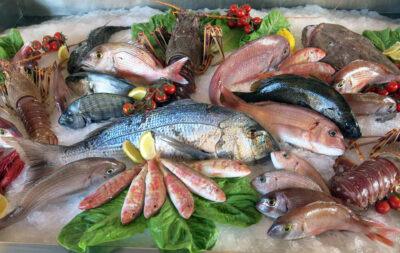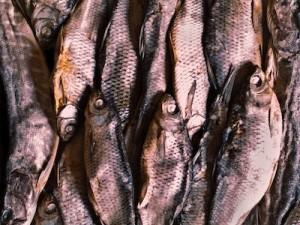|
Listen To The Article
|

Learning how to preserve fish for future consumption could be a life-saver.
Preserve fish is something a lot of fishermen don’t even consider. They may eat a lot of fish at certain times of the year but go without at other times. With all the different ways to preserve fish, you can experiment to your heart’s desire with exotic recipes and flavors, all the while stocking up for your family’s future.
Preparation To Preserve Fish
Start your preparation by cleaning your fish as soon as possible after you catch it. Experts say that fish meat deteriorates 200 times faster than beef, so the fresher the better. Some things that you can do to preserve fish and keep them fresh include: keeping them in the live well or on a stringer until you are done fishing, keeping the cleaned fish in a creel that is dipped into the water occasionally to keep them cool, or putting the fish on ice in a cooler after they are cleaned.
Scale your fish with a plain old spoon and decide if you want the skin left on or not. For catfish and bullheads, you will want to skin them. Generally, you should remove the heads from all fish you wish to preserve.
After you clean them and you are ready to work on them, decide if you will want to put them up whole or as fillets, steaks, or chunks. The method you wish to use will sometimes dictate how you should cut them.
Salting
Ancient fishermen used the practice of salting as a means to preserve fish while at sea and a long way from the market. Salt draws out moisture and dries out the fish, thereby creating an environment where microorganisms can’t function and the fish are preserved. Most of the methods listed will use salting in one form or another.
Always use pickling salt if possible because it contains no iodine or additives to keep it from clumping and is of a finer grain than other types of salt. In a pinch you can use Kosher or sea salt, but they will not perform as well. Table salt with iodine will turn everything dark and can influence flavor. You should avoid it in all but survival situations.
Brining
Brining is a method used to preserve fish in a salty liquid. It is also a flavoring step (similar to a marinade) in most of the other types of preservation.
There are two methods that you can use to brine fish. One is using salt to draw out the fish’s own moisture to create brine. A crock works well for this. First, put a layer of salt covering the bottom of the crock, and then place a layer of fish on top of it. Next, place another layer of salt, then fish again. Continue until you are out of fish or your crock is getting full. Put in a layer of salt on top and cover with a plate that fits inside the crock. Place a weight on top of the plate to hold the fish down.
The salt will draw out the liquid in the fish and create a brine. The weight on the plate will hold the fish down in the liquid. If the fish fail to make enough liquid to cover them, salty water can be added until the top layer is under the liquid. This should keep the fish for several weeks.
The second method is preparing a solution of salt and water or vinegar (or even wine) and using it to cover the fish. This brine should be at least ½ cup of salt to the gallon of water; one cup per gallon would be better. You can even use more, depending on your recipe. If you are using this brine as a marinade, other spices and flavors can be added. Soaking in this brine can last anywhere for ½ hour to a week, depending on your preference.
Smoking
When you smoke fish, you are drying it out, similar to salting, to make an environment where bacteria can’t multiply. Usually, smoking uses heat to drive off the moisture without cooking the fish. You are also adding a distinctive flavor to the fish that many find quite enticing. Smoked salmon, anyone? Some recipes and techniques call for enough heat that the fish is cooked at the same time.
Smoking works best with fillets, but you can try it with steaks or whole fish also. Smoking can be a one or two-step process. The one-step process involves taking the fresh, cleaned fish and smoking it as is. The two-step process brines the fish for a time before the smoking. You can do this to add salt to better preserve fish or to add more flavors for better palatability.
If you use a commercial smoker, then follow your manufacturer’s directions. If you are using a homemade smoker, remember to use only hardwoods, with hickory and fruitwoods being the best. Evergreens will leave a tarry coating on the fish and ruin them.
Canning
Canning fish is generally discouraged since the meat deteriorates quickly. Fish is a low-acid food and thus has a long processing time. If you attempt canning, you should cut your fish into chunks and smaller pint-sized portions so that you are sure all the meat reaches a safe processing temperature. Canning fish should always be done with a pressure canner, and you should consult the most up-to-date information available regarding processing times. That being said, home-canned salmon can be very good.
Drying
 Drying fish on a wooden rack just like our forefathers did can still be done. Fish should be salted and filleted if possible, or if small, opened up so they lay flat. They can be skewered with wooden spikes to aid in this if need be. You should also hang them in a place out of the sun with good air circulation. In addition, make sure to turn them several times a day. They should be brought in at night and sprinkled with salt if they are still damp.
Drying fish on a wooden rack just like our forefathers did can still be done. Fish should be salted and filleted if possible, or if small, opened up so they lay flat. They can be skewered with wooden spikes to aid in this if need be. You should also hang them in a place out of the sun with good air circulation. In addition, make sure to turn them several times a day. They should be brought in at night and sprinkled with salt if they are still damp.
Drying will take several days and an effort should be made to keep insects and weather away. Sometimes, you can burn a smoky fire upwind to aid in this. Again, be sure to use hardwoods only.
Freezing
Freezing fish, while requiring the least amount of work, will preserve fish at the highest quality. If you have room in the freezer and like fresh fish, this is the route you should take. For best results, use a deep freeze and not the freezer compartment on your refrigerator.
You can freeze them in a block of ice by putting your fish in a container, then filling it with water and freezing the whole thing. This works well for bulk storing.
Another method is to dip your fish in cold water and wrap it in plastic or foil and freeze without draining. A third method is dipping. Put your fish on a tray in your freezer. When frozen, take them out and dip them in water and return to the freezer. Repeat the process until you have the desired thickness of fish-sicles.
Pickling
For a real adventure in putting up your fish, you can try pickling them. Most pickling recipes take a two-step approach. First, you either brine or cook your fish, and then you immerse them in a pickling mixture and allow them to soak. There are so many different recipes and advice that it’s hard to recommend just one.
Since you are being adventurous, you should try the recipe in Bull Cook and Authentic Historical Recipes and Practices by George and Berthe Herter. George prefers brining the cleaned fish for about a week in a solution of salt and white vinegar, and then he gives the recipe for the pickling liquid with a couple of options to suit your taste (You can even turn it into a wine sauce). Once the fish are in this pickling liquid for three days, you need to put them in the refrigerator for one more day. They are then ready to enjoy.
Even people who don’t care for fish find they sometimes like it when someone puts it up in one of these ways. In hard times, putting up fish will be a valuable skill to possess.
You may also want to read 5 Clever Ways To Fish Without A Pole
What are your thoughts on other ways that you can preserve fish? Let us know in the comments below.
©2018 Off the Grid News
 Off The Grid News Better Ideas For Off The Grid Living
Off The Grid News Better Ideas For Off The Grid Living




